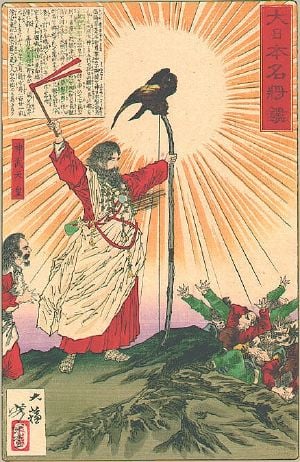Encyclopedia, Difference between revisions of "Jimmu Emperor of Japan" - New World
(copy/credit Wiki) |
(epname, claimed, cat) |
||
| Line 1: | Line 1: | ||
| − | [[Image:Emperor_Jimmu.jpg|left|thumb|250|Meiji era print of Emperor Jimmu]] | + | {{Claimed}} |
| + | {{epname}}[[Image:Emperor_Jimmu.jpg|left|thumb|250|Meiji era print of Emperor Jimmu]] | ||
'''Emperor Jimmu''' (神武天皇 ''Jinmu Tennō''; also known as: ''Kamuyamato Iwarebiko''; given name: ''Wakamikenu no Mikoto'' or ''Sano no Mikoto'', born according to the legendary account in the [[Kojiki]] on The first day of the first month, [[660 B.C.E.]], and died, again according to legend, on the eleventh day of the third month, [[585 B.C.E.]] (both dates according to the [[lunisolar calendar|traditional Japanese calendar]]), was the mythical founder of [[Japan]] and is the first emperor named in the traditional lists of emperors. The [[Emperor of Japan|Imperial house]] of Japan traditionally based its claim to the throne on its descent from Jimmu. | '''Emperor Jimmu''' (神武天皇 ''Jinmu Tennō''; also known as: ''Kamuyamato Iwarebiko''; given name: ''Wakamikenu no Mikoto'' or ''Sano no Mikoto'', born according to the legendary account in the [[Kojiki]] on The first day of the first month, [[660 B.C.E.]], and died, again according to legend, on the eleventh day of the third month, [[585 B.C.E.]] (both dates according to the [[lunisolar calendar|traditional Japanese calendar]]), was the mythical founder of [[Japan]] and is the first emperor named in the traditional lists of emperors. The [[Emperor of Japan|Imperial house]] of Japan traditionally based its claim to the throne on its descent from Jimmu. | ||
| Line 45: | Line 46: | ||
[[zh:神武天皇]] | [[zh:神武天皇]] | ||
| − | + | [[Category:History and biography]] | |
{{Credit|96690648}} | {{Credit|96690648}} | ||
Revision as of 18:51, 31 December 2006
Emperor Jimmu (神武天皇 Jinmu Tennō; also known as: Kamuyamato Iwarebiko; given name: Wakamikenu no Mikoto or Sano no Mikoto, born according to the legendary account in the Kojiki on The first day of the first month, 660 B.C.E., and died, again according to legend, on the eleventh day of the third month, 585 B.C.E. (both dates according to the traditional Japanese calendar), was the mythical founder of Japan and is the first emperor named in the traditional lists of emperors. The Imperial house of Japan traditionally based its claim to the throne on its descent from Jimmu.
The name "Emperor Jimmu" is treated as the posthumous name of this mythical figure. In fact, being Chinese in form and Buddhist in implication, it must have been awarded centuries after the lifetime ascribed to him, as part of the compilation of legends about the origins of the Yamato dynasty known as the Kojiki. "Jimmu" literally means "divine might".
According to Shinto belief, Jimmu is regarded as a direct descendant of the sun goddess, Amaterasu. Amaterasu had a son called Ame no Oshihomimi no Mikoto and through him a grandson named Ninigi-no-Mikoto. She sent her grandson to the Japanese islands where he eventually married Princess Konohana-Sakuya. Among their three sons was Hikohohodemi no Mikoto, also called Yamasachi-hiko, who married Princess Toyotama. She was the daughter of Owatatsumi, the Japanese sea god and brother of Amaterasu. They had a single son called Hikonagisa Takeugaya Fukiaezu no Mikoto. The boy was abandoned by his parents at birth and consequently raised by Princess Tamayori, his mother's younger sister. They eventually married and had a total of four sons. The last of them became Emperor Jimmu.
New Year's Day in the Japanese lunisolar calendar was traditionally celebrated as the regnal day of Emperor Jimmu. In 1872, the Meiji government proclaimed February 11, 660 B.C.E. in the Gregorian calendar the foundation day of Japan. This mythical date was commemorated in the holiday Kigensetsu ("Era Day") from 1872 to 1948, which was resurrected in 1966 as the national holiday Kenkoku Kinen no hi ("National Foundation Day").
Jimmu's migration
Mythic records in the Kojiki and Nihonshoki tell us that Jimmu's brothers were originally born in Takachiho, the southern part of Kyūshū (in modern day Miyazaki prefecture), and decided to move eastward, as they found their location inappropriate for reigning over the entire country. Jimmu's older brother Itsuse no Mikoto originally led the migration, and they move eastward through the Seto Inland Sea with the assistance of local chieftain Sao Netsuhiko. As they reached Naniwa (modern day Ōsaka), they encountered another local chieftain Nagasunehiko (lit. the long-legged man"), and Itsuse was killed in the ensuing battle. Jimmu realized that they had been defeated because they battled eastward against the Sun, so he decided to land on the east side of Kii Peninsula and battle westward. They reached Kumano, and with the guidance of a three-legged bird, Yatagarasu (lit. eight-span crow), moved to Yamato. There they once again battled Nagasunehiko and were victorious. In Yamato, Nigihayahi no Mikoto, who also claims to be a descendant of the Takamagahara gods, was protected by Nagasunehiko. However, when Nigihayahi met Jimmu, he accepted Jimmu's legitimacy, and Jimmu ascended to the throne.
Notes
External links
| Preceded by: (none) |
Legendary Emperor of Japan 660 B.C.E.-585 B.C.E. |
Succeeded by: Emperor Suizei |
ar:جينمو تينو de:Jimmu es:Emperador Jinmu eo:Jimmu fr:Jimmu ko:진무 천황 hr:Jimmu Tenno it:Jimmu imperatore del Giappone lv:Jimu nl:Jinmu ja:神武天皇 no:Jimmu pl:Jinmu pt:Imperador Jimmu fi:Jimmu sv:Jimmu Tennou zh:神武天皇
Credits
New World Encyclopedia writers and editors rewrote and completed the Wikipedia article in accordance with New World Encyclopedia standards. This article abides by terms of the Creative Commons CC-by-sa 3.0 License (CC-by-sa), which may be used and disseminated with proper attribution. Credit is due under the terms of this license that can reference both the New World Encyclopedia contributors and the selfless volunteer contributors of the Wikimedia Foundation. To cite this article click here for a list of acceptable citing formats.The history of earlier contributions by wikipedians is accessible to researchers here:
The history of this article since it was imported to New World Encyclopedia:
Note: Some restrictions may apply to use of individual images which are separately licensed.
